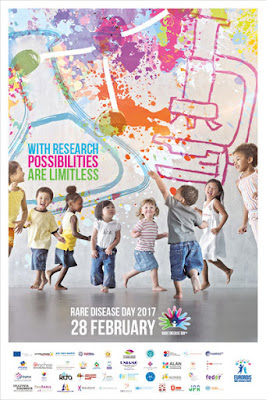On February 28th I'm honoured to be hosting a special Rare Disease Day #hcldrtweetchat. Two weeks ago Joe Babiain approached me to see if I would be interested in working something up with a rare disease focus coming up towards rare disease day. To be honest I was grateful for the opportunity for a couple of reasons. Looking back on these posts, it's obvious that there's been a bit of a hiatus on writing here. This was just the push I needed. With a Rare Disease Day theme of 'Research' this seems like the perfect time to talk about how patients, caregivers, health care providers, and researchers can create an environment of partnership to create change for the rare disease community. So, thank you, Joe. Thanks for the push and thanks for the opportunity to talk about my community, and to talk about my passion for partnership in both care and research. And I'm looking forward to the conversation on Tuesday February 28th on on #hcldr at 5:30PT (8:30ET) about patient partnership in research.
NB: I'd also I'd like to thank Joe for being a great editor and @couragesings for helping me find some great resources.
(The following was originally posted on the #hcldr blog)
It’s International Rare Disease Day on February 28th
and by the beginning of February I start to reflect on what it means to me. It
wasn’t so long ago, that frankly it didn’t mean anything at all to me. Rare and
orphan diseases didn’t have any impact on my life, or at least I didn’t think
they did or ever would. If I knew that a rare disease was defined as a disease
that affected less that 1 in 2000 people, I certainly wouldn’t think it would
have any relevance to me. However, taken all together, that means that rare
diseases in total affect 1 in 12 people – and half of them are diagnosed when
they’re children. And I wouldn’t realize that one of those 1 in 12 would come
to be my son. I wouldn’t realize that the average time to diagnosis for rare
disease patients is over 7 years and for most of these diagnoses there is noreal treatment.
All this applies for the 7000 or so named rare diseases.
Then there are those like my family – those of us still searching for a
diagnosis. We’re 15 years in. Multiple specialists in, reading study after
study, communicating with researchers directly, and left with more questions
than answers. We have piles of archived studies, ideas of where to go, but
mostly we work in partnership with our health care providers, hoping that one
day, somebody’s research bears fruit and an answer is found for our son.
This is the current state of affairs in 2017 for rare
diseases. How do we move forward? For me there is only one answer. We can only
move forward together. There is limited funding for research. There is a
limited pool of donor resources for non-profits. There is a limited pool of
study participants for research studies. There are limits everywhere. What if
we could all help each other overcome the limits we have? What if we could
amplify each other’s efforts by being more efficient with the resources we each
have. Now wouldn’t that be something? It strikes me, we go further (and faster)
together, than we do apart.
There are some incredible researchers out there doing great
work on rare disease. But they can’t do it alone. There are health care
providers seeing patients every day, with access to a pool of patients and
information. And there are patients and communities, gathering information and
resources, mobilizing to do good work. So, let’s bring them together, each to
amplify the other’s voices and information. Balanced together, that’s how we
get to the end goal.
With small study populations, tight competition for funding,
and competitive donor pools, the smart money is on research that collaborates
with patients and the rare disease community to get the work done. So the
question is, how is that done an authentic way? What is everyone’s role? How do
patients inform research? What lessons can we learn from failures? Are there
resources on how to work with patients and communities? Is research all about
the cures? Or is it about living well with #chronicillness and #raredisease?
Who decides? And how? With PCORI in the US and SPOR in Canada, how can
researchers and patient communities leverage resources to work together for
better research impact?
Join the #hcldr community of professionals, patients,
clinicians, administrators, lurkers, counselors, social workers, designers, and
advocates! Please join us on Tuesday, Feb 28, 2017 at 8:30pm Eastern (for your
local time click here) as we discuss the following topics:
- T1: How do we start to overcome barriers to engage the patient/caregiver community as research partner? What is the role for digital communication?
- T2: Is there a danger of engaging the ‘same old voices’ or in other words, how do we ensure diversity of thought?
- T3: “Tear down that wall!” Barriers – there are barriers on all sides to patient inclusion. How do we address them and overcome them?
- T4: How is rare disease a model that can lead healthcare into patient inclusion in research? Example?
Resources for Further Study
Links Mentioned in Bio:
Main Blog Links:
International Rare Disease Day http://www.rarediseaseday.org/
1/12 or 1/10 prevalence https://www.rarediseasefoundation.org/research
NORD Rare Disease Facts http://cdn.rarediseases.org/wordpresscontent/wp-content/uploads/2014/11/NRD-1008-FactSheet_5.pdf
EURORDIS Rare Diseases Europe http://www.eurordis.org/about-rare-diseases
PCORI Patient-Centered
Outcomes Research Institute http://www.pcori.org/
Additional Resources:
CORD Canadian
Organization for Rare Disorders http://raredisorders.ca/
NORD National
Organization for Rare Disorders https://rarediseases.org/
Global Genes https://globalgenes.org/
Rare Disease
Report http://www.raredr.com/
How to read and understand a scientific paper: a guide for
non-scientists http://blogs.lse.ac.uk/impactofsocialsciences/2016/05/09/how-to-read-and-understand-a-scientific-paper-a-guide-for-non-scientists/
When patients help bridge the knowledge gap in health
research clinical trials https://simondenegri.com/2017/02/24/when-patients-help-bridge-the-knowledge-gap-in-health-research-clinicaltrials-whywedoresearch-proms/





